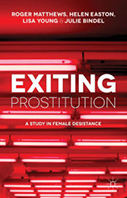Exiting Prostitution: A Study in Female Desistance

Authors: Roger Matthews, Helen Easton, Lisa Young & Julie Bindel
Publisher: London; New York: Palgrave Macmillan, 2014. 162p.
Reviewer: A. N. Cimino | May 2016
Scholarly attention on the process by which women exit prostitution and transition into a life beyond sex work has grown over the past two decades. It is well accepted that exiting prostitution is considerably more complex than ceasing to sell sex. In Exiting Prostitution: A Study in Female Desistance, authors Roger Matthews, Helen Easton, Lisa Young and Julie Bindel present their work attempting to understand the exiting process through interviews with 114 women involved in on-street and off-street prostitution, and 35 interviews with stakeholders (e.g., service providers). Throughout the book, the authors’ critical analysis and presentation of findings is impressive, integrating interview data with current literature, to create a balanced understanding of the exiting process from a desistence framework.
Chapter one focuses on the dynamics of exiting, and includes a discussion of barriers to exiting, best practices and developing a holistic approach to understanding desistance from prostitution. The chapter concludes with a summarization of the current models of exiting. Most compelling is the authors’ thesis that current literature narrowly focuses on a “staged approach to exiting” that oversimplifies the exiting process, downplays the complexities of changing one’s identity, and is merely a reflection of how researchers depicted the process (pp. 11-12). Rather, the authors maintain that a desistance framework offers more substance, particularly because it allows for reversals and failures as well as gender and prostitution-type (e.g., indoor, outdoor) differences on a pathway of desistence.
In the second chapter, the authors begin by presenting their interview findings as they discuss contentious issues in the desistance literature, namely, structure and agency; the role of formal and informal supports; the relationship between past experiences and future developments and lapses and reversals. With regard to relapses, the authors say, “rather than seeing relapses as a sign of failure… more effort needs to be made to reduce the number, frequency and duration of relapses, and to work with women to find ways to get them back on an exiting tract” (p. 42). This novel viewpoint has implications for criminal justice and social service agencies whose work is often criticized as ineffective because of high recidivism among this population. In reality, as Matthews and colleagues demonstrate, it is typical for some women to exit with ease (‘self-exiters’), while others exit and re-enter numerous times before successfully leaving prostitution.
Chapter three emphases barriers and opportunities to exiting, including drug and alcohol use, housing, financial issues, criminalization, health, and education and employment. The authors’ findings were consistent with current literature. The authors’ analysis of coercion, one of the less frequently cited barriers to exiting, is an addition to the literature. Here, they describe how women continue to sell sex despite wanting to exit because of emotional pressure such as duty, loyalty, fear or guilt from partners or pimps, as well as other significant others. This finding highlights how emotional and peer pressure to sell sex is as powerful a barrier to exiting as physical threats and force.
A closer examination of exiting among women involved in prostitution is the thesis of chapter four. Here, the authors offer findings to support different exiting routes and obstacles faced by women involved in prostitution. Much of this chapter summarizes literature on violent victimization, substance abuse, and other barriers that differ among on/off-street sex workers. Matthews and colleagues offer insight into some poignant differences with regard to exiting needs. For example, interviews with stakeholders indicated that women attempting to exit on-street prostitution needed drug treatment, affordable housing and supportive and trusting relationships. In contrast, exiting among off-street women focused on emotional shifts, self-motivation to leave, and other peer pressures.
In chapter five, Mathews, et al. review four models of service provision (i.e., harm minimization, women’s service centers, multi-agency partnerships, and case management) for exiting prostitution, ultimately advocating for a combination of models. The authors point out that the benefits of a harm minimization approach (sometimes called risk reduction) are to address immediate health needs of women engaged in sex work and to foster trust between women and service organizations. Because harm minimization makes sex work safer, it has been criticized for not helping women leave prostitution. Multi-agency partnerships work to address the wide-ranging needs of women exiting prostitution via brokered services and referrals to other organizations, but leave women feeling ‘referred away’ and passed off without a true integration of needs with service provision. Women’s service centers, on the other hand, are integrated services for female offenders, including counseling, drug treatment, housing, employment, etc., yet do not focus solely on exiting prostitution, and may not be relevant to women selling sex. Lastly, the case management approach attempts to solve fragmented services associated with the multi-agency approach via accountability provided by a case manager, who can also identity service gaps, such as those found in women’s centered service; and, who can offer tailored, prostitution-specific interventions for those seeking to exit. Thus, the case management approach appears to integrate the best components of the latter service provision models. While chapter five mentioned programs in the UK, such as in Glasgow and Ipswich, and elsewhere, the authors did not discuss diversion and exiting-specific programming found in the U.S. There is more published work on formal exiting programming in the U.S., a discussion of which could have improved Mathews et al.’s delineation of exiting service provision approaches and provided readers with other exemplary programs for exiting.
The book ends with a discussion of exiting policy and practice, which largely highlights viewpoints on choice, rights, self-determination, economic implications and societal and gender-specific barriers to exiting. The authors turn back to desistence literature to compare and contrast role changes amongst men and women, suggesting that women attempting to exit prostitution have to overcome being social and gender deviants. As such, they must deal with histories of abuse, sexual and physical trauma, shame, and gendered stigma to rebuild their lives and adopt a new role outside of prostitution. Mathews and colleagues offer eight principles, including moving beyond a deficit model of helping, recognizing that relapses are part of the exiting process, and emphasizing that social context and constraints also need to be ‘fixed’ (pp 141-142).
Other than some methodological issues, it is difficult to offer criticisms of this novel and well-crafted study on the prostitution exiting process. Instead, I will point out gaps and future areas of research that were raised. First, the prostitution research base lacks a definition of exiting, including a timeframe of abstinence from prostitution and other metrics. Researchers need a definition of exiting to establish recidivism outcomes. Furthermore, a definition of exiting may also inform a measure of readiness to exit prostitution, which is important for formal exiting programs to provide evidence-based results and secure funding. Secondly, the authors noted, some women exit prostitution with ease, while for others re-entry is common. Readers are left to wonder, what are the substantive differences between self-exiters and those who fail multiple times, and how can we, as researchers and practitioners, understand and capture the strengths and resilience of self-exiters, and then offer it to those who are struggling to exit? Lastly, as Matthews et al., and other researchers have made clear, routes of exiting and supports necessary to exit are different among women in on and off-street prostitution. However, the majority of research and programs target on-street women, thus neglecting off-street sex workers. More research is needed to develop programs that address the unique needs of off-street sex workers who want to exit, but who do not have the resources to do so.
A. N. Cimino is a Faculty Research Associate and former Postdoctoral Fellow in Interdisciplinary Violence Research (T32- HD064428) at Johns Hopkins University, School of Nursing in Baltimore, Maryland.


